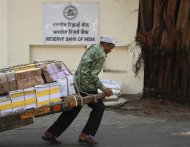By Shamik Paul and Neha Dasgupta
MUMBAI (Reuters) - The Reserve Bank of India is likely to cut its repo rate for the first time in three years in an attempt to lift sagging economic growth, even as high oil and food prices remain a challenge to managing inflation, a Reuters poll showed.Of 20 analysts polled, 17 expect the RBI to cut the repo rate by 25 basis points to 8.25 percent on April 17, while three see it unchanged at 8.50 percent.
The RBI has held its key interest rate steady since its policy review in mid-December, after raising it 13 times from March 2010 to tame high inflation, most recently in October. Its last rate cut was in April 2009.
"The driving factor for a repo cut is basically to pull down the cost of funds. The slowdown in the economy is coming from a drop in investments, and that has to be reversed," said Saugata Bhattacharya, an economist with Axis Bank.
Of 19 respondents, 13 expect no cut next week in the cash reserve ratio (CRR) requirement for banks, or the share of deposits lenders have to maintain with the RBI.
Only four respondents forecast a 50 bps cut in CRR on April 17, while two see a 25 basis point cut.
In January, the RBI cut CRR by 50 bps, and further reduced it by 75 bps in March to 4.75 percent to ease tight liquidity in the banking system ahead of advance tax payments by companies.
Economists have scaled back their expectations for rate cuts in the fiscal year that started this month but have increased their expectations for cuts in CRR since a poll in March.
The median estimate for the repo rate in March 2013 now stands at 7.75 percent, higher than the estimate of 7.50 percent in a poll last month. Similarly, the median estimate for CRR is 4 percent, compared with 4.25 percent in March.
India's economy grew at just 6.1 percent in the December quarter, the slowest in nearly three years.
High food inflation is likely to pinch Indians at least until July as fruit and vegetable output shrinks, hurt by rising temperatures and dry conditions, while edible oil and pulses prices are rallying on lower production and a more expensive world market.
The wholesale price index, the main gauge of inflation, edged up a faster-than-expected 6.95 percent from a year earlier in February. Analysts are keenly awaiting the March inflation data to be announced a day before the RBI's policy.
However, non-food manufactured inflation is likely to remain low, which will offset some of the impact of high food prices, analysts said.
Further inflationary pressure could emerge if India cuts subsidies on diesel and cooking fuels, and if state oil retailers raise the price of petrol to reflect the rise in global crude prices.
(Additional reporting by Mumbai Treasury Team; Editing by Tony Munroe and Ranjit Gangadharan)
DHANANJAY SINGH
PGDM 2ND SEM.





